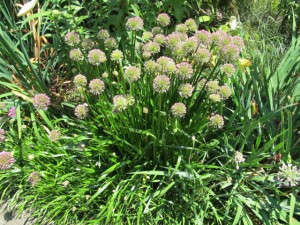Allium ‘Millennium’ is a rhizomatous type allium (onion) introduced by plant breeder Mark McDonough over a decade ago (USDA hardiness zones 5-8). In nursery catalogs it is sometimes listed Allium nutans‘Millennium’. Fleshy strap-like 12-inch long glossy green foliage emits a slight oniony smell when crushed.
‘Millennium’ is a rhizomatous (clump growing) long-lived perennial. Individual plants grow vigorously, 15-20 inches high (in bloom), and spread 10-15 inches. Round-headed rosy purple flowers, 2 inches or more in diameter, appear in mid to late July. They stay in bloom well into August. Millennium tends to bloom 7 to 10 days later, compared to ‘Pink Feathers’, another clump forming cultivar.
Tight mounds of glossy foliage, beautiful flowers, and striking seed heads offer multi-season interest. Nectar-seeking honeybees and butterflies hone in on the flowers. Clumping alliums do not seed-in and become weedy like the bulbous onion types. The dry flower stalks stand upright thru the winter months.
Clumping alliums grow in average well-drained, slightly acidic soils (pH 5.5 to 7.0). They are frequently found in open moist sites such as in rain gardens. One-year established plants become exceptionally drought tolerant and thrive in xeric rock garden soils. Grow in either full to partial sunlight (minimum 4-5 hours) is preferred to maintain their tight clumping ground cover.
Plants may be dug up and divided either in mid-autumn or in early spring before new growth emerges. Alliums are also deer and rabbit proof and usually disease and pest free.


 Posted in
Posted in 
